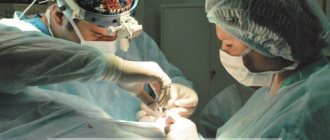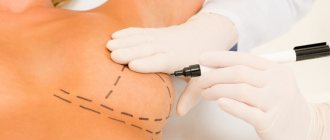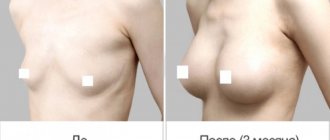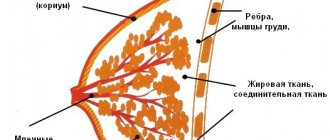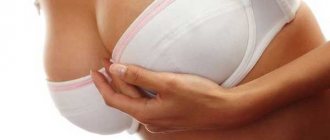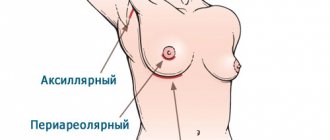“Are there any contraindications to breast augmentation?” - This is the question most patients ask when contacting a plastic surgeon or at the decision-making stage. Of course, any operation is associated with some restrictions, but you should not panic prematurely and give up your dream of beautiful and seductive forms. Our plastic surgeons have successfully performed more than 10 thousand operations. Modern material and technical equipment of the clinic named after. N.I. Pirogov in St. Petersburg, high standards of hardware and laboratory diagnostics, gentle anesthesia options make it possible to reduce the risks of mammoplasty to a minimum. For breast replacement, we use implants from reliable foreign brands, such as Allergan (USA), Mentor (USA) and Polytech (Germany).
Typically, contraindications to mammoplasty are identified on an individual basis at the initial consultation and preoperative examination. However, there is a list of restrictions that every patient should know. It is worth saying that almost none of them are absolute, which means that you can and should work with them in advance in order to realize the dream of perfect figure proportions. We talked with the head of the plastic surgery department, Oleg Leonidovich Nesteruk, to find out what medical contraindications for breast augmentation may be a reason to refuse surgery.
Why does a woman need breast augmentation?
Breast augmentation is done for:
- Naturally enlarge small breasts
- Restore breast size and shape after pregnancy, weight loss or breastfeeding
- Restore symmetry when the mammary glands are asymmetrical
- Restoring breasts after breast removal surgery
Plastic surgery includes reconstructive and aesthetic surgery .
Breast reconstructive surgery is performed as part of treatment for breast cancer. Aesthetic breast surgery is performed to improve appearance. Breast augmentation is usually an aesthetic surgery.
In 2007, a study conducted by researchers at the University of Florida found that breast augmentation through cosmetic surgery improves women's self-esteem and their feelings and sexuality. Allows you to get a higher paying job and achieve greater recognition.
Initial consultation with a plastic surgeon
At the initial consultation, the patient tells the plastic surgeon what exactly she wants to change. Mammoplasty allows you to increase or decrease the size of the breast, improve its shape, eliminate asymmetry and ptosis. The patient also reports what diseases and operations she has undergone, what medications she takes, and whether she has any allergic reactions. Based on primary information and a study of the medical history, the doctor checks whether there are any obvious contraindications to the operation.
Sometimes dissatisfaction with appearance is purely a psychological rather than an aesthetic problem. If the intervention is inappropriate and entails more risks than benefits, then the plastic surgeon will try to convince the patient and explain why the operation is not necessary in her case.
Mammoplasty is not performed during pregnancy and breastfeeding. After completion of lactation, you should wait another 6-12 months. It is not advisable for the date of the operation to coincide with menstruation.
At the initial consultation, the plastic surgeon takes measurements, calculates the volume of the patient’s breasts and selects implants together with her. Then the doctor draws up a step-by-step operation plan, which takes into account even the slightest risks and options for eliminating complications.
For the patient and the doctor, the initial consultation is a search for a compromise between wishes and anatomical data. Do not be upset if the final scenario of the operation is slightly different from the original plan with which you come to the plastic surgeon. After consultation, the doctor prescribes a comprehensive medical examination.
What are breast implants?
A breast implant is a medical device that is placed under the breast or pectoralis major muscle to enlarge, reconstruct, or create an aesthetically pleasing breast shape.
Breast implants may contain silicone, saline, or another compound.
There are three main types of breast implants:
Saline implants are filled with sterile saline, which is simply sterile salt water. The solution is contained inside a silicone shell. These implants can be filled with varying amounts of saline. This affects the sensation experienced when pressing on the mammary gland; it can be either softer or harder, at the request of the patient, in addition, different densities will determine the different shape of the mammary gland.
If the saline implant is damaged and leaking, the solution will not cause any harm to the patient, since the saline solution is natural for the body and will simply be absorbed by the body without residue, the only negative is that the implant will have to be changed since the volume of the mammary gland will decrease.
Silicone gel implants consist of a silicone outer shell filled with silicone gel. If a silicone implant leaks, the gel will either remain in the shell or end up in the breast implant pocket. And it will not spread throughout the body. Modern implants do not spread even if the shell is damaged. Currently, these implants are the most commonly used.
Alternative composite implants are rarely used and may be filled with either biodegradable material, soybean oil or some other material.
Prohibitions during surgery
Contraindications for mammoplasty are the same as for other surgical interventions, but there are still differences, since in most cases, this operation is not mandatory.
Absolute contraindications for surgery include:
- allergies to medications used for anesthesia;
- diabetes mellitus in the stage of decompensation or compensation;
- diseases in which blood clotting is impaired or long-term use of aspirin-based anticoagulants;
- systemic connective tissue diseases such as scleroderma or systemic lupus erythematosus;
- different types of immunodeficiencies;
- mental illness;
- severe chronic diseases in a state of decompensation;
- malignant neoplasms in the stage of incomplete treatment;
- acute diseases or chronic illnesses in the acute stage, which can indirectly affect the operation.
What needs to be decided before surgery?
Breast augmentation is a surgical procedure, so patients need to carefully consider whether they really need this procedure.
- It is necessary to choose where the implant will be installed - under the pectoralis major muscle or under the gland tissue. Your operating doctor will help you decide this. Most often, implants are placed under the muscle.
- Before the operation, the surgeon, together with the patient, selects the required implant size. This is done either with the help of special sizers that are placed in the bra, and the patient can evaluate the size and comfort of wearing it. In addition, the patient, together with the doctor, chooses the density of the implant and its shape (round or anatomical). Manufacturer of the implant.
- The surgeon and patient should discuss incision options.
The following options are possible:
- A submammary incision made in the crease under the breast
- Transaxillary incision in the armpit
- An incision around the edge of the areola (periareolar) or through the areola (transareolar)
The choice of incision depends on several factors, including the degree of augmentation, patient anatomy, implant type, and surgeon-patient preference.
In addition, the patient must choose the type of anesthesia; this operation is often performed under general anesthesia. But if the patient wishes, in principle this is also possible under local anesthesia.
How is the operation performed?
After the patient is put into medical sleep, or after local anesthesia, the surgeon makes a skin incision in the place, according to the type of access agreed upon with the patient, about 4.5 centimeters long, and then, using special tools, forms a pocket into which the endoprosthesis will then be placed.
The pocket can be formed either directly under the breast tissue or under the large muscle mass (this is discussed with the patient before surgery):
1. With an axillary pouch, it is placed under the pectoralis major muscle.
2. The submammary or subglandular location of the pocket is simpler, with the pocket formed in the space between the mammary gland and the pectoralis major muscle.
Suturing the wound
In their practice, plastic surgeons more often use so-called cosmetic, or more correctly, intradermal sutures; usually several rows of threads are applied, which most often do not need to be removed; over time they dissolve on their own. In addition, the plastic surgeon can use special surgical glue and special sterile strips to tighten the edges of the wound so that the scar is less noticeable in the postoperative period.
The cut lines will be visible at first, but over time they will almost disappear.
Evaluation of results
Surgery may lead to swelling and hematomas (bruises), but this should go away within two to four weeks. Usually the final result is formed no earlier than 3-6 months after the operation. Therefore, the patient will only be able to decide whether the procedure meets her expectations after some time.
Recovery period
The recovery period takes 1 month. During this period, there are certain restrictions that will be explained to the patient by the doctor and a special reminder will be issued for their exact implementation. Pain bothers the patient only on the first day after surgery; non-steroidal anti-inflammatory drugs, such as ketonal, are used for pain relief. In rare cases, narcotic analgesics. Then the pain practically goes away. There remains a slight inconvenience. After the operation, you should not swim in open or closed waters, take a bath, sleep on your back, raise your arms high, engage in active sports or heavy physical work. All these restrictions are temporary, for 1 month. Then the patient can live peacefully as she lived before the operation; she can fly on an airplane and scuba dive. The most important thing in the postoperative period is to wear special compression garments. Underwear must be worn strictly for 1 month after surgery, and then for another 3 months when playing sports or heavy physical activity.
The next day after the operation, the patient can leave the clinic if she wishes. The patient is monitored once a week, in the first two weeks, then every other month. Then after three months. And then an annual follow-up examination.
Absorbable (absorbable) sutures usually dissolve within 6 weeks. The patient will take care of the suture independently at home. This is a no-brainer.
If the patient has non-absorbable sutures, an additional visit will be required to remove them.
After the operation, the surgeon will not only tell you how to behave in the postoperative period, but will also provide you with an extract with recommendations, where it will be written:
- How to care for your breasts after the procedure
- How to use prescribed medications
- When to come for your next visit
- When to call the doctor
You should seek immediate medical attention if you experience:
- any signs of infection such as a temperature above 38 degrees, fever or redness of the skin in the chest area
- severe chest pain, or a sharp increase in the size of the mammary gland
Types of scars after mammoplasty
If breast enlargement has caused scars, you need to carefully examine the condition of the skin in order to understand exactly what type of scars appeared on the woman’s body. The method of scar removal depends on the information received, thanks to which you can restore the attractive appearance of the bust.
Today doctors divide them into several types, differing in location and external characteristics.
There are several types of sutures after mammoplasty. These include:
| Variety | Characteristic |
| Normotrophic | This type of scar looks the most pleasant after mammoplasty. They are practically undetectable by eye, and when touched on the skin they do not distinguish themselves in any way. In addition, the elasticity of such scars is no different from healthy skin. In appearance, such seams look like a thin white stripe several shades lighter than the skin. |
| Atrophic | The scar forms a small depression (as if a piece of flesh had been torn out of the body), since it is located below the level of healthy tissue. In rare cases, it pulls nearby skin towards itself and impairs motor functions. Essentially, atrophic scars are defects in skin thickness. |
| Hypertrophic | After breast augmentation surgery, the sutures may become hypertrophic. In this case, they are better visible on the body, and when touched, you can feel that the scars are rough and slightly deep. Hypertrophic scars are painted in a purple or pinkish color, which is unusual for healthy skin. As a rule, most scars protrude slightly above the epithelium, which makes them even more noticeable. However, hypertrophic sutures respond well to conservative treatment. |
| Keloid | They are considered the most dangerous and serious. Today in medicine there are many procedures that cure them and restore the attractive appearance of the bust. A keloid scar after mammoplasty protrudes above the surface of the epithelium, strongly tightens it, and also has the ability to grow throughout the mammary glands, thereby covering a considerable part of the breast. In this case, the woman needs to undergo complex treatment, because if the stitches increase, this leads to damage to the healthy skin of the bust. |
In exceptional cases, during the rehabilitation process, mixed scars are formed due to poor quality work of the surgeon and violation of the suture technique. For example, a neat normotrophic scar can become atrophic over time, and in some areas protrude upward.
What risks might this operation have?
Any surgical procedure increases the risk of sudden death from myocardial infarction, stroke, or thromboembolism during or immediately after surgery. But, fortunately, such complications are extremely rare. And in our clinic there is all the modern resuscitation and anesthesiology equipment that minimizes these risks to almost zero.
Some of the risks and complications associated with breast augmentation are:
- Painful mammary glands
- Inflammation of the mammary gland
- The sensation in the chest and nipples may temporarily change or become more or less pronounced
- Implant rupture
- Bleeding
- Fluid accumulation (seroma)
A specific complication of this operation is capsular contracture - in which a thick capsule is formed around the implant. Which can deform the mammary gland, or make it extremely painful and dense. During your consultation, the surgeon will tell you in detail about this complication and how to avoid it.
In addition, even cosmetic stitches can become red, thick and painful, or, conversely, flat and wide. This may lead to repeat surgery to remove such scars.
— Okay, the decision about breast augmentation has been made, the required amount has been accumulated. Where to begin?
— You need to choose a clinic. The issue of choosing a clinic must be approached very seriously, because this determines how the plastic surgery will be performed, the absence of complications, and the final result.
Before choosing a clinic, you should take the time to study the websites of medical institutions that perform such operations. It is advisable to check whether clinics have a license on the Roszdravnadzor website.
Preparations for lip augmentation
In cosmetology clinics, various preparations containing concentrated hyaluronic acid are used to increase lip volume. High-quality and time-tested among them are: Surgiderm 30ХР and Juvederm Ultra.
Surgiderm 30ХР
The preparations are based on hyaluronic acid of non-animal origin. It is characterized by increased viscosity and is suitable for solving aesthetic and age-related problems. Features of the compositions:
- high biocompatibility (does not cause allergies or rejection);
- strength of intermolecular bonds (suitable for sculpting);
- convenient format (available in the form of disposable syringes).
Surgiderm 30ХР is used to correct lips, fill wrinkles on the forehead and between the eyebrows, and smooth out nasolabial folds.
Juvederm Ultra 3
Juvederm Ultra 3 is the gold standard in lip contouring. Manufacturer: American company Allergan. Features of the product include painless injection under the skin, since the drug contains lidocaine, long-lasting effect, ease of uniform distribution.
Postoperative period
The patient is discharged from the hospital on the 2nd day, the sutures are removed on days 7–14. During the rehabilitation period, it is necessary to wear compression garments. Painful sensations, which are relieved with conventional painkillers, can persist for up to 5 days. During the first time after breast augmentation, swelling is noted. After a week, the patient returns to her usual rhythm of life. However, those who have an implant installed under the muscle are strictly prohibited from making sudden movements with their hands for six months. You cannot perform sports exercises on the lower part of the body for one month and on the upper part for six months. You should not lift weights sharply for a month, as well as sunbathe, this will help prevent pigmentation of the sutures. Also, for 3 months it is prohibited to visit baths, saunas, and solariums.




